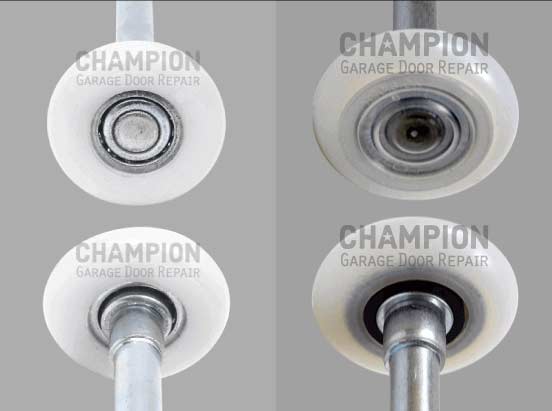Garage door rollers are a critical yet often overlooked component of overhead door systems. The door rollers not only ensure the smooth operation and movement of the garage door along its tracks but also affect the garage door noise levels.
A single faulty roller can lead to problems such as binding, excessive noise, and, in some cases, a significant breakdown that may cause the door to come off its tracks, preventing it from opening and closing. This highlights the critical role rollers play in maintaining the overall stability and safe functionality of your garage door system.
Below, we will explore the four most common types of rollers available for residential garage doors:
Stock Garage Door Roller
Many sectional garage doors manufactured before 2008 and even certain modern residential garage doors are equipped with stock factory rollers. These stock rollers are typically constructed from thin steel or less durable plastic material, making them more susceptible to deformation and breakage.
Stock rollers tend to last for a few years before issues and excessive noise may arise. These stock rollers are only available in 4-inch lengths and can support approximately 40-50 pounds of weight per roller.
11 Ball Bearing Garage Door Roller
This is a standard, high-quality roller that outperforms stock rollers. The 11 Ball Bearing Roller is designed for reliability, efficiency, and noiseless operation, despite being unsealed.
It can support up to 75 pounds of weight per roller, meaning that a set of 10 of these rollers can support a 750-pound garage door.
The 11 Ball Bearing Roller is available in both 4-inch and 7-inch stem size options and should last for approximately 10,000 to 15,000 garage door cycles. This equates to a lifespan of roughly 5-10 years with daily use.
13 Ball Bearing Garage Door Roller
The 13 Ball Bearing Roller is similar to the 11 Ball version but boasts a slightly superior and more robust design. These 13 Ball Bearing Rollers feature a sealed design, providing protection against dirt and dust. This means they tend to have a longer lifespan and may be less susceptible to wear and tear. Each 13 Ball Bearing Roller can support up to 85 pounds of weight.

Available in both 4-inch and 7-inch stem sizes, these rollers can operate seamlessly for 15,000 to 20,000 garage door cycles, equivalent to roughly 10-20 years of daily garage door use. Thanks to their nylon-sealed ball bearings, these rollers are known for their durability and reliability.
Z Bearing Garage Door Roller
The mysteriously named ‘Z Bearing’ roller stands out as the ultimate choice among rollers. Many garage door repair companies hail the Z Bearing Roller as a ‘superior’ option due to its unique design. This roller boasts individually encased ball bearings, making it exceptionally resistant to airborne dust, grime, and dirt.
The Z Bearing Roller can endure over 30,000 garage door cycles, equivalent to approximately 20-30 years of daily use, and can support up to 105 pounds of weight per roller, making it the strongest in its category. Stem options for this roller are available in both 4-inch and 7-inch sizes.
Do You Need to Replace Your Garage Door Rollers?
Follow the checklist below to determine if your door rollers need replacement:
- Press the roller’s wheel to check for any play or movement.
- Manually rotate the roller to ensure it doesn’t stick or ‘lock up’.
- Listen for any unwanted noises.
- Inspect the rollers for signs of cracking.
- Check for missing pieces on the rollers.
- Look for signs of regular wear and tear.
If the rollers’ wheels feel loose or have slack, if the rollers ‘lock up’, produce unwanted noises, or show signs of wear, it’s likely time to replace the door rollers. It’s recommended to perform this check every 6 to 12 months to ensure the safety of the garage doors. Alternatively, you can ask your garage door repair company to inspect the rollers during a service call or annual maintenance.
Why Should You Replace Your Garage Door Rollers?
Other than making an irritating sound, faulty rollers can cause significant problems. They can lead to a sudden breakdown, causing the garage door not to open or close properly, or even come off its tracks and potentially crash down. This not only could necessitate emergency repairs but can also result in damage to the door’s panels, the equipment, and vehicles parked inside the garage. Additionally, increased friction from faulty rollers can accelerate wear and tear on the garage door opener over time.
How to Replace Rollers?
Most garage door manufacturers use 5/16-inch screws or nuts to secure the hinges (which hold the rollers) in place, so you’ll need a 5/16-inch socket and an impact driver or a wrench.
Begin by disengaging the garage door from the opener using the emergency release pull. This will allow you to easily adjust the door up and down to your desired position, starting from the bottom brackets.
Be cautious not to remove the screws or nuts securing the bottom brackets, as they are connected to the cables that link to the torsion assembly. There are three methods you can use to remove the rollers from the bottom brackets:
- Using a claw hammer or locking pliers, gently bend out a small section of the curved side of the vertical track, which should be facing toward you. The goal is to create a small gap where the roller can be pushed out. It’s advisable to do this at a mid-height position. Then, position the door so that the bottom bracket’s roller is adjacent to the gap and carefully press it out of the track. Once it’s removed, replace it with a new roller and push it back into the track. Finally, use a hammer to straighten and return the bent part of the track to its original position.
- Using a 5/16-inch socket, unscrew the jamb brackets that secure the vertical track assembly, and release the track from the flag bracket. Once the track is completely loose, unwrap it from the rollers and set it aside. If you’re replacing the bottom bracket’s roller using this method, you can also replace all the other rollers at the same time. After installing all the new rollers, wrap the vertical track back around them and secure it in place.
- Unwind the springs using designated winding bars to bring the torsion assembly to its equilibrium state. Once there’s no torque coming from the springs, you can safely remove the bottom brackets and replace the rollers.
To replace all other rollers, you can simply unscrew the hinges and top brackets using a 5/16-inch socket. Do it one at the time.
Due to the weight of the garage door and the torque generated by the torsion springs, it’s advisable to consult a licensed garage door repair company if you’re unsure about how to replace the rollers.
How to Properly Maintain Door Rollers?
Due to normal wear and tear, garage door rollers are prone to becoming squeaky, stiff, or even breaking after a few years of regular use. Regardless of the type of rollers your garage door has, it’s a good practice to regularly lubricate them with an appropriate lubricant. Any lubricant that isn’t a degreaser, penetrating oil, or rust remover will suffice.
To extend their lifespan and prevent binding, it’s recommended to lubricate the rollers approximately every 6-12 months, depending on the frequency of use. If you use the door more than 5 times a day, you may want to lubricate it every 6 months.
If your rollers are dirty or covered in grime, it’s advisable to clean them before applying lubrication. The rollers and hinges are best cleaned with a dry washcloth. You can also use an air compressor to remove any debris or dust. If they continue to squeak and malfunction even after cleaning and lubrication, consider replacing them.
What Is the Best Roller for Your Garage Door?
The type of roller you need depends on various factors, including door specs, frequency of use, and your budget of course. Here are some common factors to consider when choosing the right rollers for your garage door:
- Garage Door Specs: The rollers and stem need to be able to endure the door’s weight and facilitate safe ongoing operation.
- Wheel Size: 2” wheels are ideal for residential garage door. while extremely heavy garage doors or commercial doors may require a 3″ diameter wheel.
- Roller Material: Nylon, plastic and steel are typically used as the primary material for garage door rollers. The most common material for door rollers is nylon, as it offers a good balance of durability and quiet operation for various garage doors.
- Rollers Design: Ball bearing rollers are designed to provide smoother and more efficient rolling motion compared to standard rollers which tend to have higher friction and may require more maintenance.
Overall, good quality rollers are constructed from nylon and equipped with ball bearings. These rollers often provide the best value for money as they prevent binding, ensure quiet operation, and deliver long-lasting performance.








Rollers in a garage door are important because they help the whole system to operate smoothly. My door is always making a large creaking sound when it opens and closes. It would be interesting to learn about the different types of garages that are used.
Having even one thing wrong with your roller door can cause problems with the rest of it. My wife and I have been looking for ways that we can improve my parents’ home, to make it safer and more reliable. I will keep this in mind and start looking for a roller door company that can help us take a look at it.
Our garage door was making a weird noise when opening and closing it. I lubricated the moving parts and noises were completely gone!